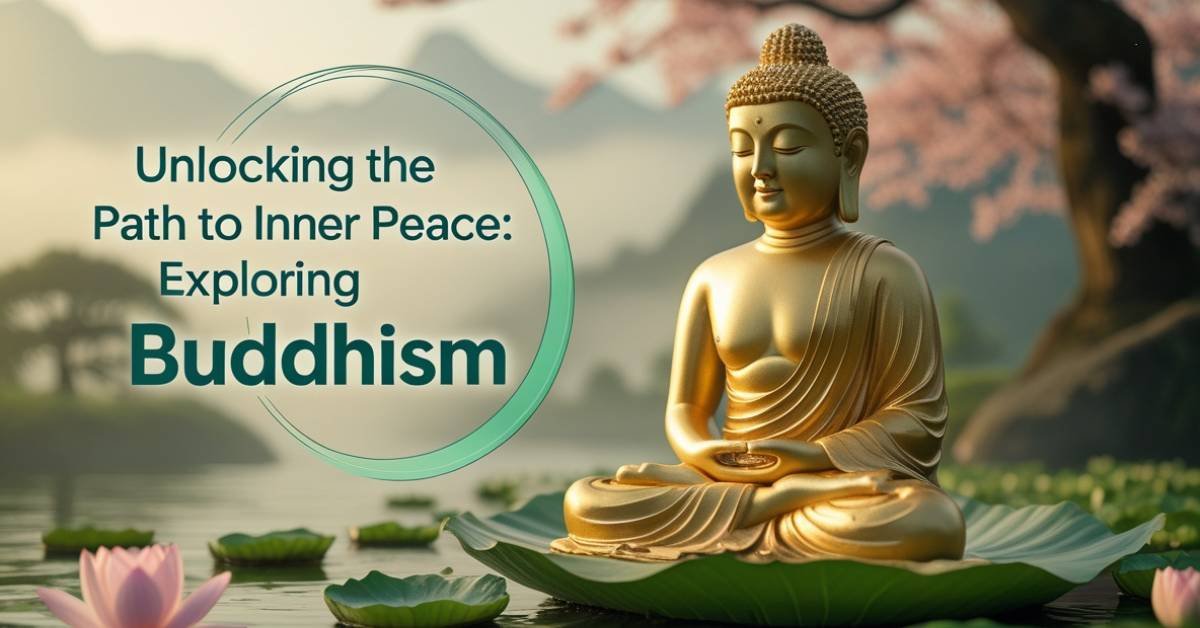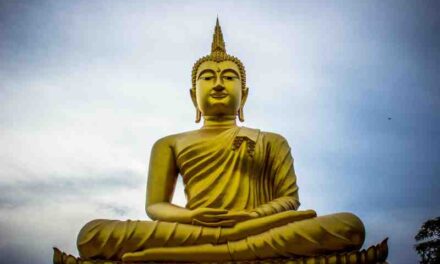Buddhism, a philosophy and religion that originated in India over 2,500 years ago, offers a profound path towards inner peace. Emerging during a time of societal unrest and spiritual seeking, Buddhism provided a unique perspective on the human condition and a practical framework for alleviating suffering1. At its core, Buddhism emphasizes the understanding of the human condition, the nature of suffering, and the cultivation of wisdom and compassion to achieve liberation from this suffering.
The Three Universal Truths
Before delving into the Four Noble Truths, it’s essential to understand the Three Universal Truths that underpin Buddhist thought. These truths provide a foundational understanding of the nature of reality and the human condition:
- Impermanence (annica): Everything in the universe is in a constant state of flux. Nothing remains the same, and all things are subject to change2. This understanding helps us to appreciate the transient nature of our experiences and to cultivate non-attachment.
- Non-attachment (anatta): There is no permanent, unchanging self or soul. What we perceive as “self” is a collection of constantly changing physical and mental processes2. This understanding helps us to let go of the illusion of a separate self and to cultivate a sense of interconnectedness with all beings.
- The Law of Cause and Effect (karma): Every action has a consequence, and our actions shape our experiences in the present and future2. This understanding encourages us to act with responsibility and to cultivate wholesome actions that lead to positive outcomes.
These Three Universal Truths provide a framework for understanding the impermanent and interconnected nature of reality, laying the groundwork for the Four Noble Truths and the path to inner peace.
The Four Noble Truths: Understanding the Nature of Suffering
The foundation of Buddhist teachings rests upon the Four Noble Truths, which provide a framework for understanding the nature of suffering and the path to its cessation. These truths are:
- Dukkha: The truth of suffering. Life inevitably involves suffering, including physical and emotional pain, dissatisfaction, and impermanence3. This truth encourages us to acknowledge the reality of suffering in our lives and in the world around us, rather than trying to ignore or suppress it. By acknowledging suffering, we can begin to understand its causes and find ways to alleviate it. For example, understanding the truth of Dukkha can help us to cope with stress and anxiety by recognizing that these experiences are impermanent and that we have the capacity to cultivate inner peace even amidst challenges.
- Samudaya: The truth of the origin of suffering. Suffering arises from craving, attachment, and ignorance. Our desires for pleasure, material possessions, and permanence create a cycle of dissatisfaction and suffering3. This truth helps us to understand that the root of suffering lies within our own minds, in our attachment to things that are impermanent and our aversion to things that are unpleasant. By recognizing the role of craving and attachment in our suffering, we can begin to cultivate detachment and find true happiness that is not dependent on external conditions.
- Nirodha: The truth of the cessation of suffering. Suffering can cease by eliminating craving and attachment. By understanding the impermanent nature of reality and cultivating detachment, we can achieve liberation from suffering3. This truth offers hope and a path forward. It tells us that suffering is not an inherent or permanent condition but rather something that can be overcome through understanding and practice. By cultivating wisdom and compassion, we can free ourselves from the cycle of craving and attachment and find lasting peace.
- Magga: The truth of the path to the cessation of suffering. The path to the cessation of suffering is the Noble Eightfold Path, a set of practices that cultivate wisdom, ethical conduct, and mental discipline3. This truth provides a practical roadmap for achieving liberation from suffering. It outlines the specific practices that we can cultivate to weaken the grip of craving and attachment and to cultivate inner peace.
The Four Noble Truths offer a pragmatic perspective on the human condition, acknowledging the reality of suffering while providing a path towards its end. By understanding the causes of suffering and cultivating the practices that lead to its cessation, we can begin to unlock the path to inner peace.
The Eightfold Path: A Path to Wisdom, Ethical Conduct, and Mental Discipline
The Noble Eightfold Path is the Buddha’s prescription for achieving liberation from suffering and cultivating inner peace. It consists of eight interconnected practices:
Wisdom (Panna)
- Right Understanding (Samma ditthi): Understanding the Four Noble Truths and the nature of reality, including impermanence and non-self5. This understanding forms the foundation for the entire path. By understanding the true nature of reality, we can make wise choices that lead to greater peace and well-being.
- Right Thought (Samma sankappa): Cultivating thoughts of loving-kindness, compassion, and non-violence5. These thoughts help to create a positive and harmonious mental state, which in turn influences our actions and interactions with others.
Ethical Conduct (Sila)
- Right Speech (Samma vaca): Abstaining from lying, harsh speech, and gossip2. Our words have a powerful impact on ourselves and others. By speaking truthfully, kindly, and with awareness, we can create positive relationships and contribute to a more harmonious environment.
- Right Action (Samma kammanta): Acting ethically and with non-violence, refraining from killing, stealing, and harmful actions2. Our actions shape our karma and our experiences in the world. By acting ethically and with compassion, we create positive karma and contribute to the well-being of ourselves and others.
- Right Livelihood (Samma ajiva): Earning a living in an ethical and harmless way2. This precept encourages us to choose occupations that do not harm others or contribute to suffering. It also encourages us to approach our work with mindfulness and integrity.
- The Five Precepts: In addition to the precepts outlined in the Eightfold Path, Buddhism also emphasizes the Five Precepts as guidelines for ethical conduct. These precepts are: not harming living things, not stealing, not lying, not misusing sex, and not taking intoxicants7. By adhering to these precepts, we can cultivate a more virtuous and peaceful life.
Mental Discipline (Samadhi)
- Right Effort (Samma vayama): Cultivating wholesome mental states and abandoning unwholesome ones5. This practice involves making a conscious effort to cultivate positive mental states such as loving-kindness, compassion, and joy, while abandoning negative mental states such as anger, greed, and hatred.
- Right Mindfulness (Samma sati): Paying attention to the present moment without judgment, observing thoughts, feelings, and sensations5. Mindfulness is a key practice in Buddhism, helping us to develop greater self-awareness and to break free from habitual patterns of thinking and behavior.
- Right Concentration (Samma samadhi): Developing focused attention and mental clarity through meditation5. Right Concentration builds upon Right Mindfulness, allowing us to develop deeper states of focus and mental stability. This can be achieved through various meditation techniques, such as focusing on the breath or on a mantra.
The Eightfold Path is not a linear progression but rather a set of interconnected practices that support and reinforce each other. For example, Right Mindfulness helps to cultivate Right Concentration by training the mind to stay focused on the present moment. Both Right Mindfulness and Right Concentration contribute to ethical conduct by increasing our awareness of our thoughts and actions, allowing us to make wiser choices. By cultivating wisdom, ethical conduct, and mental discipline, we can gradually weaken the grip of craving and attachment, leading to greater inner peace and liberation from suffering.
Karma and its Role in Inner Peace
The concept of karma is central to Buddhist teachings. Karma refers to the law of cause and effect, where our actions have consequences that shape our experiences in the present and future3. Understanding karma can help individuals make choices that lead to greater peace and well-being. By cultivating wholesome actions motivated by kindness and compassion, we create positive karma that leads to happiness and inner peace. Conversely, negative actions motivated by greed, hatred, and delusion create negative karma that leads to suffering.
Karma is not a system of punishment or reward but rather a natural law of cause and effect. By understanding this law, we can take responsibility for our actions and make choices that lead to greater peace and harmony in our lives.
Nirvana: The Ultimate Goal of Inner Peace
In Buddhism, the ultimate goal is to achieve Nirvana, a state of complete liberation from suffering and the cycle of birth and death. Nirvana is often described as a state of profound peace, tranquility, and enlightenment10.
Nirvana is not a place or a heaven but rather a state of mind characterized by the extinction of greed, hatred, and delusion. It is achieved through the cultivation of wisdom, ethical conduct, and mental discipline, as outlined in the Eightfold Path10. While Nirvana is the ultimate goal in many Buddhist traditions, some schools, like Mahayana, emphasize Buddhahood as the highest attainment11.
There are two types of Nirvana:
- Sopadhishesa-nirvana: Nirvana with a remainder, achieved during life when the fires of greed, hatred, and delusion are extinguished. However, the physical body and the five aggregates of clinging still remain10.
- Parinirvana: Nirvana without a remainder, or final Nirvana, achieved at death when all attachments are extinguished, and the cycle of rebirth ends10.
Furthermore, Buddhism recognizes two types of freedom that contribute to the attainment of Nirvana:
- Ceto-vimutti: Freedom of mind, achieved through meditation and the cultivation of mental discipline. This involves overcoming desires and achieving a state of inner peace and tranquility12.
- Pañña-vimutti: Freedom through wisdom, achieved through the development of insight into the true nature of reality. This involves understanding the Four Noble Truths, the concept of non-self, and the impermanent nature of all things12.
By cultivating both Ceto-vimutti and Pañña-vimutti, we can progress towards the ultimate goal of Nirvana and experience lasting inner peace.
While the concept of Nirvana may seem abstract, it serves as a guiding principle for Buddhist practice, inspiring individuals to cultivate the qualities that lead to lasting peace and liberation.
Schools of Buddhism: Diverse Perspectives on Achieving Inner Peace
Over the centuries, Buddhism has evolved into various schools and traditions, each with its unique emphasis and practices. Some of the major schools of Buddhism include:
- Theravada Buddhism: The oldest surviving school of Buddhism, prevalent in Southeast Asia, emphasizes the individual’s path to enlightenment through meditation and mindfulness13. Theravada Buddhism places a strong emphasis on monasticism and the study of the Pali Canon, the earliest collection of Buddhist scriptures.
- Mahayana Buddhism: Prevalent in East Asia, emphasizes the Bodhisattva ideal, where individuals strive for enlightenment not only for themselves but also for the benefit of all beings13. Mahayana Buddhism is characterized by its emphasis on compassion and its development of the concept of emptiness (sunyata).
- Vajrayana Buddhism: Prevalent in Tibet, incorporates esoteric practices and rituals to accelerate the path to enlightenment13. Vajrayana Buddhism is known for its use of visualizations, mantras, and mandalas as tools for spiritual transformation.
- Nyingma School: One example within Vajrayana Buddhism is the Nyingma school, the oldest of the Tibetan Buddhist schools14. Nyingma emphasizes the practice of Dzogchen, often translated as “the Great Perfection.” Dzogchen encourages practitioners to recognize the innate purity of the mind, transcending conceptual thoughts and dualities to achieve enlightenment.
Despite their differences, all schools of Buddhism share the core principles of the Four Noble Truths, the Eightfold Path, and the pursuit of Nirvana. They offer diverse perspectives and practices for cultivating inner peace and achieving liberation from suffering.
Practical Applications of Buddhist Teachings in Daily Life
Buddhist teachings are not merely theoretical concepts but offer practical tools for cultivating inner peace in everyday life15. Some of the key applications include:
- Mindfulness Meditation: By paying attention to the present moment without judgment, we can cultivate greater awareness of our thoughts, feelings, and sensations. This practice helps to reduce stress, increase focus, and develop emotional regulation9. Mindfulness can be incorporated into various daily activities, such as walking, eating, and even working.
- Cultivating Compassion: By developing empathy and concern for the suffering of others, we can cultivate a sense of interconnectedness and reduce self-centeredness. Compassion motivates us to act with kindness and to contribute to the well-being of others17. Compassion can be cultivated through practices such as loving-kindness meditation (metta) and tonglen, where we visualize taking in the suffering of others and sending out compassion.
- Ethical Living: By aligning our actions with the principles of non-violence, honesty, and compassion, we can create a more harmonious and ethical life. This includes making conscious choices in our relationships, work, and consumption habits16. Ethical living can involve practices such as vegetarianism, mindful consumption, and engaging in right livelihood.
By incorporating these practices into our daily lives, we can gradually transform our minds and cultivate greater inner peace, even amidst the challenges of the modern world.
Scientific Evidence Supporting the Benefits of Buddhist Practices
In recent years, scientific research has provided evidence supporting the benefits of Buddhist practices for mental health and well-being. Studies have shown that mindfulness meditation can reduce stress, anxiety, and depression, improve attention and focus, and promote emotional regulation13. For example, Mindfulness-Based Stress Reduction (MBSR) programs have been shown to be effective in reducing stress and improving overall well-being.
Neuroimaging studies have also shown that meditation can alter brain structure and function, increasing activity in areas associated with attention, emotional regulation, and compassion13. These findings suggest that Buddhist practices can have a profound impact on our mental and emotional well-being, supporting the traditional claims of their efficacy in cultivating inner peace.
Personal Stories and Case Studies
Throughout history, countless individuals have found inner peace and transformation through the teachings of Buddhism. Personal stories and case studies provide inspiring examples of how Buddhist practices can be applied to overcome challenges and cultivate greater well-being19.
For example, individuals who have struggled with anger, anxiety, or addiction have found that mindfulness meditation and other Buddhist practices can help them to develop greater self-awareness, emotional regulation, and compassion, leading to a more peaceful and fulfilling life21. One individual, after years of struggling with anger, found that practicing mindfulness allowed him to observe his anger without judgment, understand its roots, and ultimately transform it into a source of wisdom and compassion.
These personal accounts demonstrate the transformative potential of Buddhism and its ability to unlock inner peace, even in the face of adversity.
Challenges and Limitations of Following the Buddhist Path
While Buddhism offers a profound path towards inner peace, it is essential to acknowledge the challenges and limitations that may arise in its practice. Some of the challenges include:
- Maintaining Motivation: The path to enlightenment can be long and arduous, requiring sustained effort and dedication. It can be challenging to maintain motivation and commitment, especially amidst the distractions and demands of modern life22.
- Overcoming Habitual Patterns: Our minds are often conditioned by habitual patterns of thinking and behavior that can be difficult to overcome. It requires consistent effort and mindfulness to break free from these patterns and cultivate new ways of being22.
- Dealing with Difficult Emotions: Buddhist practice involves facing and accepting difficult emotions such as anger, fear, and sadness. This can be challenging and may require guidance and support from experienced practitioners22.
Despite these challenges, the potential rewards of following the Buddhist path are significant. By acknowledging and addressing these limitations, we can cultivate greater resilience and perseverance on our journey towards inner peace.
Applying Buddhism to Address Contemporary Issues
Buddhist teachings offer valuable insights and practices for addressing contemporary issues such as stress, anxiety, and social injustice. Mindfulness meditation and other Buddhist practices can help individuals to cope with stress, develop greater emotional resilience, and cultivate compassion for themselves and others23.
Buddhist principles of non-violence, compassion, and interconnectedness can also inspire social action and contribute to creating a more just and peaceful world. Engaged Buddhism, a movement that applies Buddhist principles to social and environmental issues, is gaining momentum in addressing contemporary challenges23. For example, Engaged Buddhists are involved in peace activism, environmental protection, and social justice movements. The concept of “interbeing” 23 highlights the interconnectedness of all beings and encourages us to see ourselves as part of a larger web of life, promoting cooperation and understanding.
By integrating Buddhist teachings into our personal and collective lives, we can cultivate greater inner peace and contribute to a more compassionate and harmonious world.
Buddhism offers a profound path towards inner peace by providing a framework for understanding the nature of suffering and the practices that lead to its cessation. The Four Noble Truths, the Eightfold Path, and the concept of Nirvana serve as guiding principles for cultivating wisdom, ethical conduct, and mental discipline.
While the path may have its challenges, the potential rewards of inner peace, compassion, and liberation are significant. By incorporating Buddhist teachings into our daily lives and applying them to address contemporary issues, we can unlock the path to inner peace and contribute to a more compassionate and harmonious world.
Synthesis
This research paper has explored the teachings of Buddhism, highlighting its core principles, practices, and potential for unlocking inner peace. The following table summarizes the key findings:
| Concept | Description | Relevance to Inner Peace |
|---|---|---|
| Three Universal Truths | Foundational principles of impermanence, non-attachment, and the law of cause and effect. | Provide a basis for understanding the nature of reality and cultivating inner peace. |
| Four Noble Truths | The foundation of Buddhist teachings, outlining the nature of suffering and the path to its cessation. | Provides a framework for understanding and overcoming suffering. |
| Eightfold Path | A set of eight interconnected practices that cultivate wisdom, ethical conduct, and mental discipline. | Offers a practical path for achieving liberation from suffering and cultivating inner peace. |
| Karma | The law of cause and effect, where our actions shape our experiences. | Encourages responsible action and the cultivation of wholesome deeds. |
| Nirvana | The ultimate goal of Buddhist practice, a state of complete liberation from suffering and the cycle of birth and death. | Represents the ultimate state of inner peace and enlightenment. |
| Schools of Buddhism | Diverse traditions and interpretations of Buddhist teachings. | Offer various perspectives and practices for achieving inner peace. |
| Mindfulness Meditation | Paying attention to the present moment without judgment. | Cultivates self-awareness, reduces stress, and promotes emotional regulation. |
| Cultivating Compassion | Developing empathy and concern for the suffering of others. | Reduces self-centeredness and promotes interconnectedness. |
| Ethical Living | Aligning actions with principles of non-violence, honesty, and compassion. | Creates a more harmonious and ethical life. |
| Scientific Evidence | Research supporting the benefits of Buddhist practices for mental health and well-being. | Validates the traditional claims of Buddhism’s efficacy in cultivating inner peace. |
| Personal Stories | Inspiring examples of individuals who have found inner peace through Buddhism. | Demonstrates the transformative potential of Buddhist practices. |
| Challenges and Limitations | Acknowledging the difficulties and potential obstacles in Buddhist practice. | Promotes greater resilience and perseverance on the path to inner peace. |
| Contemporary Applications | Applying Buddhist teachings to address modern issues such as stress, anxiety, and social injustice. | Contributes to personal and collective well-being and a more compassionate world. |
Works cited
1. Buddha And The Path To Happiness – An Overview, accessed on January 27, 2025, https://www.pursuit-of-happiness.org/history-of-happiness/buddha/
2. The Buddhist Core Values and Perspectives for Protection Challenges – UNHCR, accessed on January 27, 2025, https://www.unhcr.org/sites/default/files/legacy-pdf/50be10cb9.pdf
3. Basics of Buddhism – PBS, accessed on January 27, 2025, https://www.pbs.org/edens/thailand/buddhism.htm
4. The Four Noble Truths – Spirit Rock Meditation Center, accessed on January 27, 2025, https://www.spiritrock.org/practice-guides/the-four-noble-truths
5. Noble Eightfold Path – Wikipedia, accessed on January 27, 2025, https://en.wikipedia.org/wiki/Noble_Eightfold_Path
6. Noble Eightfold Path / The Threefold Learning – University of Hawaii System, accessed on January 27, 2025, http://www2.hawaii.edu/~donnab/religion/Hawaii-March%208-2020-The_Noble_Eightfold_Path-Handout.pdf
7. Buddhism: Basic Beliefs | URI – United Religions Initiative, accessed on January 27, 2025, https://www.uri.org/kids/world-religions/buddhist-beliefs
8. The Noble Eightfold Path – Spirit Rock Meditation Center, accessed on January 27, 2025, https://www.spiritrock.org/practice-guides/the-noble-eightfold-path
9. Buddhist meditation: types, techniques & how to practice — Calm Blog, accessed on January 27, 2025, https://www.calm.com/blog/buddhist-meditation
10. Nirvana (Buddhism) – Wikipedia, accessed on January 27, 2025, https://en.wikipedia.org/wiki/Nirvana_(Buddhism)
11. Nirvana | Definition, Meaning & Significance – Britannica, accessed on January 27, 2025, https://www.britannica.com/topic/nirvana-religion
12. Introduction to Buddhism | FSI – SPICE – Stanford, accessed on January 27, 2025, https://spice.fsi.stanford.edu/docs/introduction_to_buddhism
13. The Influence of Buddhist Meditation Traditions on the Autonomic System and Attention, accessed on January 27, 2025, https://pmc.ncbi.nlm.nih.gov/articles/PMC4471252/
14. The Four Schools of Tibetan Buddhism – Namchak Community, accessed on January 27, 2025, https://www.namchak.org/community/blog/four-schools-of-tibetan-buddhism/
15. How Buddhism and Modern Psychology Can Enhance Life Quality | Meridian University, accessed on January 27, 2025, https://meridianuniversity.edu/content/how-buddhism-and-modern-psychology-can-enhance-life-quality
16. Exploring Secular Buddhism: A Practical Guide To Modern Buddhist Wisdom, accessed on January 27, 2025, https://mindfulstoic.net/exploring-secular-buddhism-a-practical-guide-to-modern-buddhist-wisdom/
17. What is Compassion, or Karuna? | Buddhism A–Z – Lion’s Roar, accessed on January 27, 2025, https://www.lionsroar.com/buddhism/compassion-karuna/
18. How Buddhism Benefits Mental Health | NAMI: National Alliance on Mental Illness, accessed on January 27, 2025, https://www.nami.org/faith-community-leader/how-buddhism-benefits-mental-health/
19. HOW I LEARNED CHANGED MY MINDSET | Buddhist Story – YouTube, accessed on January 27, 2025, https://www.youtube.com/watch?v=Z92S1HRgfho
20. IF YOU WANT REAL INNER PEACE THEN YOU MUST WATCH THIS | PEACE | Buddhist story on peace | – YouTube, accessed on January 27, 2025, https://www.youtube.com/watch?v=JNi8T1OqrZY
21. A Practical Guide on Finding Inner Peace | Jack Kornfield | Knowledge Project Podcast 156, accessed on January 27, 2025, https://m.youtube.com/watch?v=D9ayv-y4XBo&pp=ygUMI2Jhc2ljdHJ1dGhz
22. Challenges to Buddhist meditation practice now, accessed on January 27, 2025, https://secularbuddhistnetwork.org/challenges-to-buddhist-meditation-practice-now/
23. Buddhism and Social Action: Engaged Buddhism – The Pluralism Project, accessed on January 27, 2025, https://pluralism.org/buddhism-and-social-action-engaged-buddhism
24. Buddhism in the 21st Century – Tricycle: The Buddhist Review, accessed on January 27, 2025, https://tricycle.org/beginners/decks/modernity/





